How does a cell respond to signals from the outside world?
Hormones or neurotransmitters are examples of such external messages. The cell surface has receptors to detect them. So-called G protein-coupled receptors, or GPCRs for short, are one of the major classes of such receptors. They are proteins positioned on the membrane of the cell.
Once activated by an external stimulus, they start internal cellular processes that have a significant impact on cell migration, growth, metabolism, and communication. Additionally, this collection of more than 800 receptors is crucial in many disorders.
GPCRs are now significant pharmacological targets as a result. In actuality, 35% of all medications that the US Food and Drug Administration (FDA) has approved target GPCRs, representing a market worth an estimated 180 billion US dollars annually.
The study of GPCRs faces considerable difficulties despite being so crucial. First, many of the so-called ligand substances that attach to them are unknown. Second, even recognized ligands may not be readily available inside the body or result in undesirable side effects.
Third, it might be challenging to identify reactions when the same receptor is found on many bodily cells. For example, the same GPCR may control inflammation in immune cells while relaxing muscles in bronchial tissue.
“We wanted to overcome these limitations. So we developed an accessible and effective toolbox for everyone, who studies GPCRs,” says Rouven Schulz, a doctoral student at the Institute of Science and Technology Austria (ISTA) and lead author of the study published in Nature Communications.
But we see in our data that there are subtle differences between receptors even when they drive the same overall pathway. That suggests fine-tuned properties that transcend these standard canonical pathways. Now, we have a possibility to look into these details.
Sandra Siegert
Mimicking a receptor
Simply put, Schulz and his colleagues created synthetic GPCR copies. The clones are blind to the original external signals, but they can be activated by a different medication that is specifically made to solely signal to this receptor and is thus simple to manage.
The authors were able to create chimeras of almost any GPCR using the well-known framework for making Designer Receptors Exclusively Activated by Designer Drugs (DREADDs). They selected the widely important human β2AR receptor as their proof-of-concept example. Known medication clozapine-N-oxide preferentially activates the β2AR replica.
“Once we had a prototypic chimera of β2AR, we could successfully reproduce many of the original’s behavior in the living organism. Amazingly, the chimera mimics the receptor accurately across many functions,” explains Schulz.
The procedure was lastly applied by the researchers on microglia cells. These immune cells are essential for maintaining the central nervous system as a whole, including the brain. They are continually searching for pathogens and broken or dysfunctional neural connections.
Microglia cells must have GPCRs, in particular the β2AR, in order to perform these tasks. The microglia cells repeated the process of causing inflammation in the nervous system thanks to our chimeric receptor, the β2AR.
The bigger picture
One can see a wide array of GPCRs while examining microglia cells and immune cells as a whole. However, no one now understands why species and people have such a variety of these receptors.
GPCRs are frequently grouped according to the primary signaling routes that they use to transmit signals.
“But we see in our data that there are subtle differences between receptors even when they drive the same overall pathway,” says Assistant Professor Sandra Siegert. “That suggests fine-tuned properties that transcend these standard canonical pathways. Now, we have a possibility to look into these details.”
The researchers is currently employing stem cells to adapt the procedure to the human regime. By doing this, scientists want to learn more about how different inflammatory features vary in response to GPCR stimulation.





